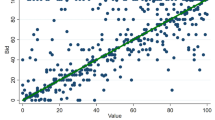Abstract
We examine how buyers’ behaviors, sellers’ profits and the social welfare (the total surplus of all sellers and buyers) vary with the order of sellers in sequential auctions where sellers have different reservation values. First, when reserve prices are exogenously set to be sellers’ reservation values, a social planner would order sellers from low to high based on their reservation values, which yields a uniquely efficient order that maximizes the social welfare. However, an auctioneer charged with maximizing the total profit of all sellers would want to reverse the increasing order in certain situations. Second, when reserve prices can be endogenously selected in addition to the order of sellers, the auctioneer would always want to adopt the increasing order for the optimally chosen reserve prices. Sequential auctions with optimally chosen reserve prices and an increasing order are shown optimal among the class of voluntary and incentive-compatible mechanisms.


Similar content being viewed by others
Notes
In a monotone equilibrium, buyers’ bidding strategy is a monotone function of their values.
Sellers are assumed to never join any auction as buyers.
In other words, we assume that buyers’ private values are equal to or higher than the lower reservation value of the sellers.
We consider sealed-bid auctions in this paper. The problem becomes more complicated in a completely open auction where in each sequential auction, all bids are observable by all buyers. Pure strategy equilibrium does not exist in general in such an open auction because if there were a pure-strategy equilibrium, all buyers could infer all others’ values after the first auction, leaving no private information to the buyers and resulting in no pure strategy equilibrium in the remaining auctions (with the exception of the last auction in second-price auctions).
\(p_1=\emptyset \) when no one wins the auction.
For example, this can be implemented by letting the sellers bargain over the order and corresponding transfers based on the following bargaining rule. Begin with a default order. Seller L proposes a new order together with a transfer, and seller H either accepts or rejects L’s proposal. If seller H accepts, the transfer is made and the order is committed; Otherwise, both sellers commit to the default order. In the equilibrium, the order should be the one maximizing the total expected profit.
For now the reserve prices are fixed to be the reservation values hence are not part of the equilibrium. Instead, the order of the reservation values is the equilibrium object. Later in Sect. 5 we allow the reserve prices to be endogenously determined.
We notice that reversing the order is not always beneficial to sellers’ total profit for two reasons: First, a decreasing order could reduce overall supply too much, then the sellers’ profit is hurt even though the bids become higher; second, reversing the order does not always reduce overall supply. To see the latter, suppose there are two bidders with values \(v_{L}=5\) and \(v_{H}=15\), and two items with reserve prices 0 and 10. With an increasing order the bidder with \(v_{H}\) gets the item with reserve price 0 and the one with \(v_{L}\) gets no item; Whereas if the order is reversed it is possible that both items are sold (the high reserve price item to the H-value bidder and the low reserve price item to the L-value bidder).
Let us also compare a simultaneous mechanism. Notice that the simultaneous second-price (truth-telling) auction with two different reserve prices needs to be carefully defined. If both bids are higher than \(r\), each bidder wins one item and pays the price \(r\); if there is only one or no bid exceeds \(r\), the bidder with a higher bid wins (random tie breaking) and pays the price of the other bid. This mechanism ensures truth telling, yields the socially efficient outcome and gives each seller a payoff equal to that in the sequential mechanism with increasing reserve prices. However, in the same situation described above, the auctioneer could still prefer a sequential auction with decreasing order to this simultaneous mechanism because the former yields a higher total profit.
The intuition can be seen from a very simple example: In a single-item first-price auction with private values \(i.i.d.\) uniformly on \([0,\bar{v}]\), one’s bid \(b(v)=v/2\) is independent from \(\bar{v}\) as long as \(v\le \bar{v}\).
With such a value, the bidder is indifferent among any bids with amount less than \(r\), which leads to zero payoff.
In the calculation, they share the same differential equation.
Whereas in sequential auctions with increasing reserve prices, the (trivial) threshold simply equal the first reserve price.
Proposition 23.D.1, p.884, Mas-Colell et al. (1995), MWG hereafter.
Assume that the virtual valuation is continuous and strictly increasing. A sufficient condition for the latter is the weakly decreasing inverse hazard rate, i.e. \(\frac{1-F(x_{i})}{f(x_{i})}\).
Recall that the optimal reserve price is higher than its corresponding reserve value (i.e. \(r^{*}(\alpha )=\phi ^{-1}\left( \alpha \right) >\alpha \)) suggests that selling items whenever some bids exceed their reserve prices is indeed supplying too much.
For the last equation, notice that the buyer will win w.p.1 in the round \(j+1\) when \(y_{j}=x\).
Recall \(f_{(2)}(x)=N(N-1)(1-F(x))f(x)F(x)^{N-2}\).
See, e.g. Proposition 23.D.2, p.888, MWG.
References
Ashenfelter O (1989) How auctions work for wine and art. J Econ Perspect 3:23–36
Beggs A, Graddy K (1997) Declining values and the afternoon effect: evidence from art auctions. RAND J Econ 28(3):544–565
van den Berg G, van Ours J, Pradhan M (2001) The declining price anomaly in dutch rose auctions. Am Econ Rev 91:1055–1062
Caillaud B, Mezzetti C (2004) Equilibrium reserve prices in sequential ascending auctions. J Econ Theory 117:78–95
Harris M, Raviv A (1981) Allocation mechanisms and the design of auctions. Econometrica 49:1477–1499
Mas-Colell A, Whinston MD, Green JR (1995) Microeconomic theory. Oxford University Press, Oxford
McAfee P, Vincent D (1997) Sequentially optimal auctions. Games Econ Behav 18:246–276
Milgrom P, Weber R (1982) A theory of auctions and competitive bidding. Econometrica 50:1089–1122
Milgrom P (2004) Putting auction theory to work. Cambridge University Press, Cambridge
Myerson R (1981) Optimal auction design. Math Oper Res 6:58–63
Weber R (1983) Multiple-object auctions. In: Engelbrecht-Wiggans R, Shubik M, Stark R (eds) Auctions, bidding, and contracting. UP, New York, pp 165–191
Author information
Authors and Affiliations
Corresponding author
Additional information
We thank Matthew O. Jackson, Thomas D. Jeitschko, R. Preston McAfee, Paul Milgrom and Seminar Participants at the 2007 CES Annual China Conference, the 4th Pan-pacific Game Theory Conference, the 3rd Asian Decentralization Conference and “Logic and Economics” 2008 workshop in Tsukuba. Special thanks to the editor Atila Abdulkadiroglu, an associate editor and two referees for very helpful suggestions and comments.
Appendix
Appendix
This appendix considers the general setting with \(M\ge 2\) sellers. Seller \(k\) sells in the \(k^{th}\) auction with the reserve price \(r_{k}\). All \(r_{1},\ldots ,r_{M}\) are predetermined and commonly known by all buyers before the auction begins. We say the reserve prices are increasing if \(r_{1}\le \ldots \le r_{M}\).
Propositions 7, 8 and 9 are generalized versions of Propositions 1, 2 and 4 respectively, and Corollary 3 is the generalized version of Corollary 1. Finally we offer the omitted proofs for Corollary 2 and Lemma 2.
Proposition 7
In first-price sequential auctions with increasing reserve prices \(r_{1}\le \ldots \le r_{M}\), there exists a symmetric, monotone, pure-strategy equilibrium. The bidding strategy is characterized in a recursive form as follows (\(j=1,\ldots ,M-1\)):
Proof of Proposition 7
Suppose such a monotone pure-strategy symmetric equilibrium exists. After any round \(j<M\), all remaining buyers learn the winner’s value in round \(j\) as \(y_{j}(p_{j})=\left( b^{(j)}\right) ^{-1}(p_{j})\), where \(p_{j}\) is the winning bid revealed. Based on this information, the updated belief over the remaining \(N-j\) buyers’ values is \(\left( x_{i}\right) _{i}\overset{i.i.d.}{\sim }F(x;y_{j})=F(x)/F(y_{j})\).
In the last (\(M^{th}\)) round, all remaining buyers bid as if they were in a single first-price auction with \(N-M+1\) buyers, whose values are i.i.d. from \(F(x;y_{M-1})\). Hence buyers with values higher than \(r_{M}\) bid above the reserve price, following the strategy
which is independent from \(y_{M-1}\).
Now we consider round \(j\) for any \(j<M\). It is essentially the last round for any buyer with a value \(x\in [r_{j},r_{j+1}]\). As a result, the strategy is \(b^{(j)}(x)=x-\frac{\int _{r_{j}}^{x}F(s)^{N-j}ds}{F(x)^{N-j}}\), following the same argument as above.
The only item left to solve is the bidding strategy for a buyer with \(x>r_{j+1}\). Let \(G\) be the cdf of the highest value of all remaining buyers (other than the buyer being considered). It is easy to see \(G(s;y_{j-1})=\frac{F(s)^{N-j}}{F(y_{j-1})^{N-j}}\). Further, denote the buyer’s expected utility, viewed in round \(j\), by \(EU^{(j)}\). In equilibrium we have:
On the RHS, the first term is the buyer’s expected utility from winning an item in round \(j\), and the second term is his/her expected utility from later rounds. FOC w.r.t. \(b\) at \(b=b^{(j)}(x)\) is: (Notice \(\left( b^{(j)}\right) ^{-1}(b)|_{b=b^{(j)}(x)}=x\))
Further, \(EU^{(j+1)}(x,b^{(j+1)}(x),s)|_{s=x}=x-b^{(j+1)}(x)\).Footnote 18 Therefore:
Recall that \(G(x;y_{j-1})=\frac{F(x)^{N-j}}{F(y_{j-1})^{N-j}}\), hence \(G(x)/dG(x)\) is indeed independent from \(y_{j-1}\).
The strategy in the proposition is the solution to the above differential equation, combined with the boundary condition given by \(b^{(j)}(r_{j+1})\). Finally, it is easy to verify that the bidding strategy is indeed increasing, and hence it is a qualified equilibrium strategy. \(\square \)
Proposition 8
In second-price sequential auctions with increasing reserve prices \(r_{1}\le \ldots \le r_{M}\), there exists a symmetric, monotone, pure-strategy equilibrium. The bidding strategy is as follows (\(j=1,\ldots ,M-1\)):
Proof of Proposition 8
The proof will proceed similarly as that for the first-price case. In the last (\(M^{th}\)) round, it is a dominant strategy for all buyers to bid their values. In the \(j^{th}\) round (for \(j<M\)), it is essentially the last round for buyers with \(r_{j}\le x\le r_{j+1}\), and hence it is a dominant strategy for them to bid their own values. The rest is to solve the bidding strategy in the \(j^{th}\) round, from the perspective of a buyer with \(x>r_{j+1}\). We first suppose that the winning bid in round \(j-1\) is \(p_{j-1}\) and hence the winner’s value \(y_{j-1}=\left( b^{(j-1)}\right) ^{-1}(p_{j-1})\). Again, let \(G\) be the cdf of the highest value of all remaining buyers (other than the buyer being considered). It is easy to see \(G(s;y_{j-1})=\frac{F(s)^{N-j}}{F(y_{j-1})^{N-j}}\). Further, denote the buyer’s expected utility, viewed in round \(j\), by \(EU^{(j)}\). In equilibrium (by submitting a bid \(b\ge r\)):
with FOC w.r.t. \(b\) at \(b=b^{(j)}(x)\):
Since the conditions that \(y_{j}=x\) implies all remaining (\(N-j-1\)) buyers in round \(j+1\) have values no more than \(x\), the buyer with value \(x\) will win w.p.1 in that round. Hence \(EU^{(j+1)}(x,b^{(j+1)}(x),x)=x-E\{payment\}\), where
\(E\{payment\}=\frac{1}{F(x)^{N-j-1}}\int _{0}^{x}max\left\{ r_{j+1},b^{(j+1)}(s)\right\} dF(s)^{N-j-1}\).
Plugging the above into the FOC gives us the equilibrium strategy:
Finally, it is easy to verify that the bidding strategy is indeed increasing, and hence it is a qualified equilibrium strategy. \(\square \)
In an equilibrium without increasing reserve prices, it is possible that all buyers drop out of some auctions. For instance, in Proposition 3 no buyers bid in the first auction. It is sufficient for us to focus on those remaining active auctions, where some buyers bid higher than the reserve prices. The sequence of active reserve prices is a subsequence of the initial reserve prices that belong to the active auctions.
Proposition 9
There exists no symmetric monotone pure-strategy equilibrium for either first-price or second-price sequential auctions if the active reserve prices (in auctions where buyers don’t fully drop off) are not increasing, i.e. \(\exists k<l\) s.t. \(r_{k}>r_{l}\).
Proof of Proposition 9
We start with the first-price auctions, and suppose that there exists a symmetric monotone pure-strategy equilibrium where the active reserve prices are not increasing. From now on, we completely ignore rounds with non-active reserve prices, since no one bids in these rounds in this equilibrium. Without loss of generality we suppose that the last two reserve prices are decreasing such that \(r_{M'-1}>r_{M'}\); Otherwise, consider the largest \(k\) such that \(r_{k-1}>r_{k}\) and all subsequent reasoning follows the same argument.
Consider the case where there are \(l\) buyers left in the \((M'-1)^{th}\) auction. Since there might be either \(l\) or \(l-1\) buyers in the \((M')^{th}\) auction, the symmetric bidding strategies would be either \(b_{l,FPA}^{(M')}\) or \(b_{l-1,FPA}^{(M')}\).
We consider the bidding strategy in the \((M'-1)^{th}\) auction, and start by calculating the threshold (\(t_{M'-1}\)): the buyer with this private value would be indifferent between entering the \((M'-1)^{th}\) auction (which means to bid above the reserve price \(r_{M'-1}\)) or not. So we only need to consider the case where this buyer has the highest value among all remaining buyers, otherwise entering the \((M'-1)^{th}\) auction or not is surely indifferent. This buyer’s payoff is:
thus \(r_{M'-1}=b_{l}^{(M')}(t_{M'-1})\). Use the same FOC as in the proof of Proposition 7,
Since \(b_{l,FPA}^{(M')}(s)>b_{l-1,FPA}^{(M')}(s)\), the derivative of \(b_{l,FPA}^{(M'-1)}(x)\) is negative near the threshold so that it is not a valid equilibrium bidding strategy.
The same method generates the same result in the second-price case. Thus there is no symmetric, monotone, pure-strategy equilibrium. \(\square \)
Corollary 3
With increasing reserve prices, the expected profits for all sellers and the expected payoffs for all bidders in first-price sequential auctions are identical to the corresponding ones in second-price sequential auctions.
Proof of Corollary 3
We first prove the payoff equivalence for the bidders using Myerson (1981) ’s method. Denote \(q:X^{N}\rightarrow [0,1]^{N}\) as the item-allocation rule, in which \(q_{i}(x_{1},\ldots ,x_{N})\) is \(i\)’s probability of getting an item given all bidders’ valuations. Both first-price and second-price auctions implement the same item-allocation rule \(q_{r}\) when using the same set of increasing reserve prices. Further, the revelation principle suggests that the auctions are mechanisms in which bidders first announce their types and both auctions are Bayesian Nash Incentive Compatible (BIC). Then the FOCs for (BIC) pin down the bidder’s expected payoff. \(\Pi (x_{i},x_{i})\) is bidder \(i\)’s payoff with value \(x_{i}\) and truthful announcement \(x_{i}\):
The above applies to both auctions, and \(\Pi (0,0)=0\) in both auctions. Hence all bidders’ expected payoffs are identical between first-price and second-price auctions.
One quick corollary from the above equivalence is that the total expected profits of sellers are the same in first-price and second-price auctions. Now we prove that these profits are the same for each individual seller by induction. First, we claim that the last seller’s profits are the same. In the last auction, buyers’ bidding strategies are the same as those in a standard one-shot auction, thus the last seller’s profits are equivalent by standard revenue equivalence result. Then, we look at the second last seller’s profits in first-price and second-price auctions. From the propositions on the equilibrium bidding strategy, buyers’ strategies in the last two auctions are the same as those in a sequential auction of two items and \(N-M+2\) buyers. This is because the bidding strategy is independent of the previous winner’s value. The quick corollary above claims that sellers’ total profits are the same in the sequential first-price and second-price auctions of two items. It implies that given each possible winner’s value of the previous auction, the last two sellers’ total profits are the same. In first-price and second-price auctions, the previous winner’s value has the same distribution. Thus, the last two sellers’ total expected profits are the same. Given that the last seller’s profit is the same by induction, the second last seller’s profit has to be the same. By the same induction, each seller’s profit is the same in first-price and second-price auctions. \(\square \)
1.1 Other omitted proofs
Proof of Corollary 2
We denote the expected total profit of sellers \(\mathbb {E}\Pi _{(r,0)}\) and \(\mathbb {E}\Pi _{(0,r)}\), respectively. Following Proposition 3, all buyers bid 0 in the first auction if the reserve prices are \((r,0)\). Thus from our discussion in mechanism design part, we have:
\(\mathbb {E}\Pi _{(0,r)}=\mathbb {E}_{\varvec{x}}\left[ \left( \phi (x_{(2)})+\phi (x_{(1)})-r\right) \cdot 1_{\{x_{(2)}\ge r\}}+\phi (x_{(1)})\cdot 1_{\{x_{(2)}<r,x_{(1)}\ge 0\}}\right] \)
\(\mathbb {E}\Pi _{(r,0)}=\mathbb {E}_{\varvec{x}}\left[ \phi (x_{(1)})\cdot 1_{\{x\ge 0\}}\right] \)
Hence \(\Delta \equiv \mathbb {E}\Pi _{(0,r)}-\mathbb {E}\Pi _{(r,0)}=\mathbb {E}_{\varvec{x}}\left[ \left( \phi (x_{(2)})-r\right) \cdot 1_{\{x_{(2)}\ge r\}}\right] =\int \limits _{r}^{1}\left[ x-\frac{1-F(x)}{f(x)}-r\right] f_{(2)}(x)dx\).
Notice \(\frac{d\Delta }{dr}=\left[ \frac{1-F(r)}{f(r)}\right] f_{(2)}(r)-\int \limits _{r}^{1}f_{(2)}(x)dx\), and henceFootnote 19
\(\frac{d^{2}\Delta }{dr^{2}}=N(N-1)(1-F(r))F(r)^{N-3}f(r)\left[ (N-2)(1-F(r))-F(r)\right] \).
Therefore, as \(r\rightarrow 1\) we have \(\Delta \rightarrow 0,\frac{d\Delta }{dr}\rightarrow 0\) and \(\frac{d^{2}\Delta }{dr^{2}}<0\). As a result, there exists \(\epsilon >0\) s.t. \(\Delta <0\) for \(\forall r\in (1-\epsilon ,1)\).
Finally, \(\hat{r}=\max \{r^{*},1-\epsilon \}\) gives a threshold in our Corollary. \(\square \)
Proof of Lemma 2
Buyers’ utility functions are quasi-linear and have bounded partial derivative with respect to \(x_{i}\), i.e. \(\frac{\partial }{\partial x_{i}}u_{i}(g(\hat{x}_{i},x_{-i}),x_{i})=q_{i}(\cdot )\le 1 (\forall i,\forall x_{i},\hat{x}_{i},x_{-i})\). Hence we have the envelope form of (BIC) as (for \(\forall i,\ \forall x_{i}\)) \(U_{i}(x_{i})=\mathbb {E}_{x_{-i}}U_{i}(0,x_{-i})+\mathbb {E}_{x_{-i}}\int _{0}^{x_{i}}q_{i}(s,x_{-i})ds\), which increases in \(x_{i}\). As a result, (IIR) reduces to \(\mathbb {E}_{x_{-i}}U_{i}(0)\ge 0\), with equality holds in any optimal mechanism. Otherwise all payments can be increased by a small amount \(\epsilon >0\), which leads to a strictly higher profit for the sellers.
Following standard arguments in optimal mechanism design,Footnote 20 the sellers’ total profit can be expressed as a function of the allocations:
Plugging in the expression of the total cost \(C(q)=\sum _{j\le \left[ q\right] }\alpha _{(M-j+1)}+\alpha _{\left( M-\left[ q\right] \right) }\cdot (q-\left[ q\right] )\), it is easy to see the results in the Lemma. \(\square \)
Rights and permissions
About this article
Cite this article
Gong, Q., Tan, X. & Xing, Y. Ordering sellers in sequential auctions. Rev Econ Design 18, 11–35 (2014). https://doi.org/10.1007/s10058-013-0152-z
Received:
Accepted:
Published:
Issue Date:
DOI: https://doi.org/10.1007/s10058-013-0152-z




